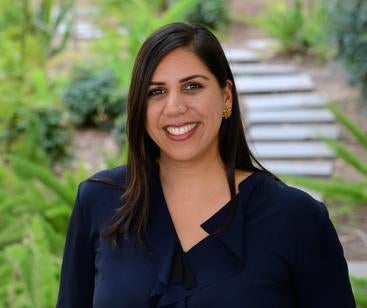Picture your favorite childhood teacher: Was she a white woman? If you grew up and attended a public school in the United States, statistics indicate she probably was.
Historically, the average American public school teacher has always been a white woman. Even today, white teachers continue to comprise 80 percent of the country’s 3.8 million public school teachers, according to data released in 2017 by the National Center for Education Statistics.
What has shifted more dramatically, however, are the demographics of public school students in the United States. Of the 50.7 million students who entered public elementary and secondary schools in fall 2017, 26.3 million — nearly 52 percent — were students of color. As student bodies grow increasingly diverse, it’s becoming more and more difficult to ignore the representation gap between students of color and the mostly white teachers who serve them.
For researchers such as Rita Kohli, the problem of teacher diversity is an especially pressing one. A former teacher in Northern California’s Oakland Unified School District, Kohli, who is South Asian, has experienced firsthand the marginalization and alienation that accompany being a teacher of color on a predominately white staff.
Kohli arrived at the University of California, Riverside four years ago and is now an assistant professor in UCR’s Graduate School of Education. She studies efforts to recruit and retain teachers of color at a time when annual rates of attrition, or teacher loss, are 24 percent higher for teachers of color than for white teachers.
“What we have to understand if that even if teachers of color are serving mostly students of color, they’re still joining a predominately white workforce,” Kohli said. “They experience microaggressions and often carry invisible labor that other teachers don’t, and those things have major effects on their retention.”
How the representation gap affects teachers
In 2011, while a postdoctoral fellow at Santa Clara University, Kohli co-founded the Institute for Teachers of Color Committed to Racial Justice, or ITOC, along with San Jose State professors Marcos Pizarro and Rebeca Burciaga.
With a heavy focus on professional development, the annual three-day conference is designed to support the leadership capacities of teachers of color who work in public schools serving mostly students of color.
The institute is expected to host roughly 120 teachers from around the country this year, culled from a pool of more than 200 applicants; after being held in San Jose for four years and Los Angeles for three, it will make its debut at UCR from June 21-23.
Kohli said the conference’s programming is fluid and changes each year depending on what attendees list as their most critical needs or concerns during the application process. In the past, those concerns have included coping with increased standardized testing pressures; resource inequities; and the current racial and political climate.
Additionally, many teachers of color contend with outsize workloads and the feelings of burnout that go hand in hand with entering a low-paying profession and working in less-funded schools with higher levels of staff turnover and overall instability.
“Teachers of color are often asked to take on leadership roles that aren’t recognized professionally or through compensation, like running student clubs or connecting with parents,” Kohli added. “There’s also a kind of undermining that happens to teachers of color when they’re engaging well with their students; rather than being seen as intellectually capable, creative educators, teachers have been asked, for example, whether they’re related to students, or are in gangs because they relate so well to gang-affiliated youth. It has the effect of diminishing those teachers’ success and their sense of professional belonging.”
ITOC: Changing teachers’ lives
For many attendees, the institute is also a place to temporarily relieve themselves of the burden of being the only teacher of color in their schools. Samantha Mathis, who has taught in middle and high schools in South Dakota, Nebraska, and now Minnesota, knows the feeling well.
“Something I feel most strongly on a regular basis is helplessness,” said Mathis, who is black but grew up in a white family. “I’m the only female teacher of color at my school, and therefore I often feel I’m the one fighting every battle for every child of color. It’s exhausting, and very lonely for me when it comes to my colleagues.”
Attending ITOC for the first time in 2017 was an eye-opening experience for Mathis.
“(It was) the most people of color I had ever been around in my entire life,” she said.
Mathis plans to return this summer, and noted one of her major takeaways from last year’s event was the potential influence she can have on students by giving them the opportunity to see and learn from a person of color in a leadership position.
As a male teacher of color, Juan Córdova is even more of a rarity in professional circles. The Washington state-based fifth-grade teacher, who attended ITOC in 2015 and 2017 and is scheduled to attend the 2018 session, described his impressions of the institute in much the same way as Mathis.
“My first time at ITOC was the first time I was even able to see more than three male teachers of color,” said Córdova, who is Latino. “I hadn’t realized how much I hadn’t had those kinds of interactions previously.”
Córdova emphasized how seeing himself reflected in peers reaffirmed his belief in his work’s impact. Following his first ITOC experience, he asked two friends to join him for round two; the trio later created a networking and support group for local educators of color. Córdova, meanwhile, has sought out new ways to integrate social justice work into his fifth graders’ lessons, including by having his students complete advocacy projects that allow them to identify and reflect on issues they’re passionate about.
“Every year, I try to make sure we have at least one project that’s based on them doing research on something important to them that has value,” he added. “Not because the curriculum or state standards say so, but because it’s a reflection of the community they live in.”
Next steps for teacher diversity
In addition to lesson modeling, institute participants enjoy keynote talks by veteran educators, gain access to mentorship opportunities and academic readings usually hidden behind pricey paywalls, and deconstruct their experiences as teachers of color in workshop settings.
By the conference’s end, the change in teachers’ demeanors is tangible, said Tanisha Johnson, a doctoral student in UCR’s Graduate School of Education who has volunteered to help Kohli run the program since 2016.
“The teachers seem lighter, like their shoulders aren’t hunched over anymore,” said Johnson, herself a former schoolteacher with more than a decade of experience. “As a teacher, you’re always trying to help someone else, but you’re never really looking at how you can help yourself. The institute is a place where teachers can finally exhale.”
Still, Kohli remains aware of the larger challenges associated with increasing teacher diversity — challenges that can’t necessarily be solved by a three-day conference. Individual schools, for example, could arrange for young teachers of color to be mentored by veteran teachers of color. On a larger scale, districts could create social or co-curricular networks for teachers of color to lean on as support systems.
“I use the example of one black teacher I met during my research,” Kohli explained. “He was a math teacher in his first year out of college, and everywhere he went to interview, they would say, ‘We need you so much — our black boys need you.’
“Even though he was only 25 and still figuring out how to teach, he said he didn’t feel like he was being interviewed to be a math teacher; he felt like he was being interviewed to be a savior of black boys,” she continued. “If there had been veteran black male teachers at those schools, he probably wouldn’t have been put in such a position.”
Regardless of the battles ahead, Kohli remains convinced of the value of working to keep teachers of color in the profession. She emphasized how teachers of color tend to have stronger understandings of equity issues and often serve as “community brokers,” thus closing the gap between school and home. Notably, students of all races have reported preferring teachers of color.
“There’s a well of untapped potential that we’re not paying enough attention to,” Kohli added. “These are teachers who want to transform schools — how can we provide them with the tools and space they need to realize their larger visions for the profession?”




